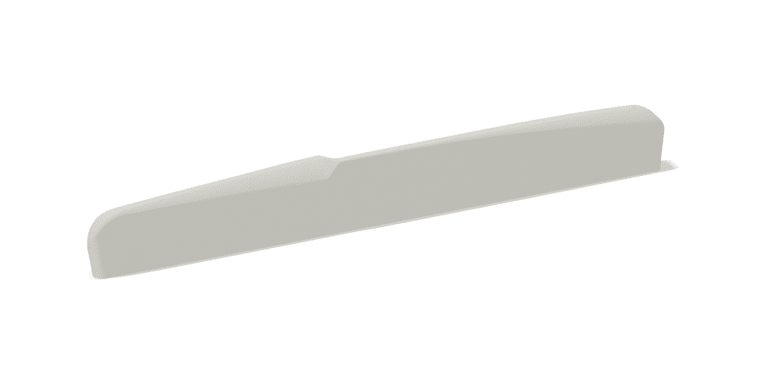Find the Correct Saddle for Your Collings® Acoustic Guitar
Are you searching for a Collings steel-string acoustic guitar saddle? Unfortunately, no single saddle size exists. This can make finding the proper saddle for your guitar difficult. Although this guide will help, we suggest that you also measure your guitar’s bridge saddle slot for a proper fit. If you are not the guitar’s original owner, someone may have installed a different saddle, adjusted the saddle slot, or even installed a different bridge or neck at some time, thus producing different specs from the factory’s original specs.
Step One: Measure Saddle Top Radius
Collings acoustic fretboards often have a compound radius of 14” – 26”, but this may be different depending on the individual guitar. Depending on the year and model, you will find differences not only in the fretboard radius, but also with the saddle radius, so measuring is important. Your saddle’s radius is likely either 12 inches or 18 inches, but we advise that you either contact Collings support with your serial number and ask what saddle radius was used on your guitar, or remove your current saddle and measure the top radius.
You can print radius gauges, but note that 18” gauges are rare. As such, we advise that you first check to see whether your saddle is a 12” radius as this is a common gauge. If not, it may be an 18” radius. Check your saddle against the 16″ and 20” radius gauges. If slightly flatter than the 16” and slightly rounder than the 20”, then you likely have an 18” radius.
Step Two: Determine Compensation Pattern
Zig Zag Compensated
Collings guitars often have a zig zag compensated saddle, whether drop in or through installation (discussed in the next section).
This saddle pattern type contains two backward compensation slants – one for the two plain strings, and one for the four wound strings.
The below image provides a top-down view of a Collings style drop in zig zag compensated saddle, shown at a three degree bridge saddle slot angle. This will provide a view of the approximate location that each string sits on the saddle top, but this will vary depending on string spacing. This compensation pattern type of saddle puts the treble E and G strings forward, the D and A strings toward the center, and the B and bass E strings compensated backward toward the bridge pins.

At first glance, the Collings drop-in saddle looks similar to the Martin drop in wave saddle. However, we advise against using a Martin style saddle on a Collings guitar as five key differences appear.
First, the compensation pattern is different. The Martin saddle is a wave style saddle and for the wound strings only has backward compensation for the bass E string, whereas the Collings saddle has graduated backward compensation for the wound strings. The below image provides a top-down view of a Martin style drop in saddle, shown at a three degree bridge saddle slot angle.

Second, we suggest that you check your bass to treble edge height difference. Martin factory drop in saddles often have a 2 mm height variance, whereas many guitar saddles have a 1 mm height variance.
Third, Martin saddles have a 16 inch radius, whereas Collings saddles are often either 12 or 18 inches.
Fourth, the Collings saddle length is shorter – 72.5 mm versus 74 mm for Martin.
Fifth, corners are different. Collings saddles have setback corners with a large radius.
Center Line Non-Compensated
Your Collings might instead have a center line non-compensated saddle. Although it might seem as though all non-compensated saddles are the same, differences do appear. Please see our Guide to Non-Compensated Saddles for more information.
Step Three: Determine Installation Method
There are two saddle installation types for Collings acoustic guitars: Drop In or Through saddle. Below is a discussion of each.
Drop In Saddle

The term “drop in saddle” refers to a saddle that is not glued in and is thus relatively easily installed and removed without adding or removing glue. But please note that drop in does not mean that these saddles are one-size-fits all, and if you purchase a new saddle, you will likely need to adjust it to your specific guitar’s saddle slot, as well as to your playability preferences. Please measure your current saddle before ordering a new one. See our Bone Saddle – Fits Some Collings Guitars for a 10 mm tall saddle.
Through Saddle
A through saddle, listed on the Collings site as “cutthrough,” goes all the way through the bridge. These are often found on Traditional Series models, but Collings does offer a drop in saddle option for Traditional Series models for those seeking to use an undersaddle pickup. Through saddles appear on other Series models, too. This type of saddle is much more difficult to install.
Collings through saddles will often have a zig zag compensation pattern somewhat similar to that found on the zig zag compensated drop-in saddles, but in a through saddle construction. Through saddles may also be center line non-compensated.
Step Four: Measure Length, Thickness, Maximum Height, Bass/Treble Edge Height Difference
Each guitar will have a different saddle size, even from the factory. Each guitar will have a slightly different neck angle, and so although the factory might set the twelfth fret action at a specified height, this can be achieved through a combination of adjusting the neck relief, nut slot height, or saddle height, resulting in different saddle sizes for different guitars, even from the factory.
We advise that you remove your current saddle and measure length, thickness, maximum height, and bass to treble edge height difference. We also advise that you measure your bridge saddle slot’s length and thickness. Wood can subtly shift with humidity and you may need a slightly longer or thicker saddle.
View or article on How to Remove the Saddle Without Completely Restringing for tips.
What Saddle Size Does Your Collings Need?
If you are still unsure of which saddle your Collings acoustic guitar needs, please contact us with the below details.
• Guitar Year, Model, Saddle Radius
• Current Saddle Length, Height, Thickness, Bass to Treble Edge Height Difference – Must be measured with a caliper
• Guitar Saddle Slot Length, Thickness (if different from saddle specs) – Must be measured with a caliper
• Current Saddle Compensation Pattern (please send a picture if you are not sure what type you have)
• Saddle Installation Method – Drop In or Through
• String Spacing at the Bridge
We reply to all messages within 48 hours.
